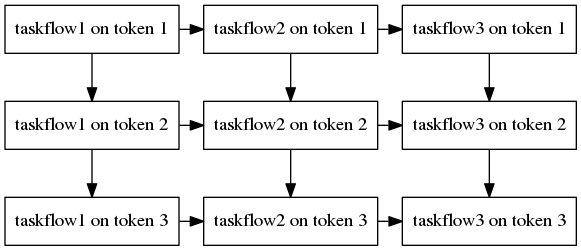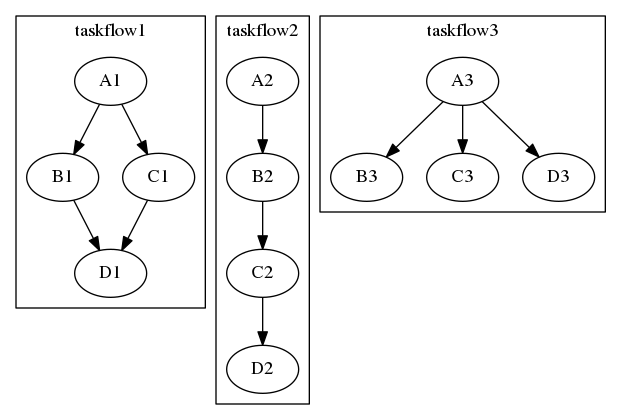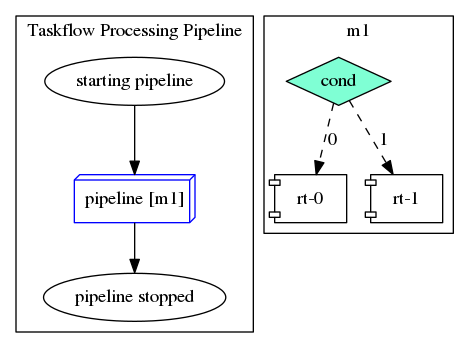We study a taskflow processing pipeline that propagates a sequence of tokens through linearly dependent taskflows. The pipeline embeds a taskflow in each pipe to run a parallel algorithm using task graph parallelism.
Formulate the Taskflow Processing Pipeline Problem
Many complex and irregular pipeline applications require each pipe to run a parallel algorithm using task graph parallelism. We can formulate such applications as scheduling a sequence of tokens through linearly dependent taskflows. The following example illustrates the pipeline propagation of three scheduling tokens through three linearly dependent taskflows:
Each pipe (stage) in the pipeline embeds a taskflow to perform a stage-specific parallel algorithm on an input scheduling token. Parallelism exhibits both inside and outside the three taskflows, combining both task graph parallelism and pipeline parallelism.
Create a Taskflow Processing Pipeline
Using the example from the previous section, we create a pipeline of three serial pipes each running a taskflow on a sequence of five scheduling tokens. The overall implementation is shown below:
auto [A1, B1, C1, D1] =
tf.emplace(
[](){ printf("A1\n"); },
[](){ printf("B1\n"); },
[](){ printf("C1\n"); },
);
A1.precede(B1, C1);
D1.succeed(B1, C1);
}
auto [A2, B2, C2, D2] =
tf.emplace(
);
tf.linearize({A2, B2, C2, D2});
}
auto [A3, B3, C3, D3] =
tf.emplace(
);
A3.precede(B3, C3, D3);
}
int main() {
const size_t num_lines = 2;
const size_t num_pipes = 3;
make_taskflow1(taskflows[0]);
make_taskflow2(taskflows[1]);
make_taskflow3(taskflows[2]);
if(pf.token() == 5) {
pf.stop();
return;
}
printf(
"begin token %zu\n", pf.token());
executor.
run(taskflows[pf.pipe()]).wait();
}},
executor.
run(taskflows[pf.pipe()]).wait();
}},
executor.
run(taskflows[pf.pipe()]).wait();
}}
);
.name("starting pipeline");
.name("pipeline stopped");
executor.
run(taskflow).wait();
return 0;
}
class to create an executor for running a taskflow graph
Definition executor.hpp:50
tf::Future< void > run(Taskflow &taskflow)
runs a taskflow once
Definition executor.hpp:1573
class to create a pipe object for a pipeline stage
Definition pipeline.hpp:136
class to create a pipeflow object used by the pipe callable
Definition pipeline.hpp:42
class to create a pipeline scheduling framework
Definition pipeline.hpp:312
class to create a task handle over a node in a taskflow graph
Definition task.hpp:187
const std::string & name() const
queries the name of the task
Definition task.hpp:499
void dump(std::ostream &ostream) const
dumps the task through an output stream
Definition task.hpp:573
Task & precede(Ts &&... tasks)
adds precedence links from this to other tasks
Definition task.hpp:420
Task & composed_of(T &object)
creates a module task from a taskflow
Definition task.hpp:436
class to create a taskflow object
Definition core/taskflow.hpp:73
taskflow namespace
Definition small_vector.hpp:27
main taskflow include file
Define Taskflows
First, we define three taskflows for the three pipes in the pipeline:
auto [A1, B1, C1, D1] =
tf.emplace(
[](){ printf("A1\n"); },
[](){ printf("B1\n"); },
[](){ printf("C1\n"); },
);
A1.precede(B1, C1);
D1.succeed(B1, C1);
}
auto [A2, B2, C2, D2] =
tf.emplace(
);
tf.linearize({A2, B2, C2, D2});
}
auto [A3, B3, C3, D3] =
tf.emplace(
);
A3.precede(B3, C3, D3);
}
As each taskflow corresponds to a pipe in the pipeline, we create a linear array to store the three taskflows:
make_taskflow1(taskflows[0]);
make_taskflow2(taskflows[1]);
make_taskflow3(taskflows[2]);
Since the three taskflows are linearly dependent, at most one taskflow will run at a pipe. We can store the three taskflows in a linear array of dimension equal to the number of pipes. If there is a parallel pipe, we need to use two-dimensional array, as multiple taskflows at a stage can run simultaneously across parallel lines.
Define the Pipes
The pipe definition is straightforward. Each pipe runs the corresponding taskflow, which can be indexed at taskflows with the pipe's identifier, tf::Pipeflow::pipe(). The first pipe will cease the pipeline scheduling when it has processed five scheduling tokens:
if(pf.token() == 5) {
pf.stop();
return;
}
printf("begin token %zu\n", pf.token());
executor.
run(taskflows[pf.pipe()]).wait();
}},
executor.
run(taskflows[pf.pipe()]).wait();
}},
executor.
run(taskflows[pf.pipe()]).wait();
}}
Define the Task Graph
To build up the taskflow for the pipeline, we create a module task with the defined pipeline structure and connect it with two tasks that output helper messages before and after the pipeline:
.name("starting pipeline");
.name("pipeline stopped");
Submit the Task Graph
Finally, we submit the taskflow to the execution and run it once:
executor.
run(taskflow).wait();
One possible output is shown below:
ready
begin token 0
A1
C1
B1
D1
begin token 1
A2
B2
A1
C1
B1
D1
C2
D2
A3
D3
C3
B3
begin token 2
A2
B2
C2
D2
A1
C1
B1
D1
A3
D3
C3
B3
A2
B2
C2
D2
begin token 3
A3
D3
C3
B3
A1
C1
B1
D1
begin token 4
A2
A1
C1
B1
D1
B2
C2
D2
A3
D3
C3
B3
A2
B2
C2
D2
A3
D3
C3
B3
stopped




